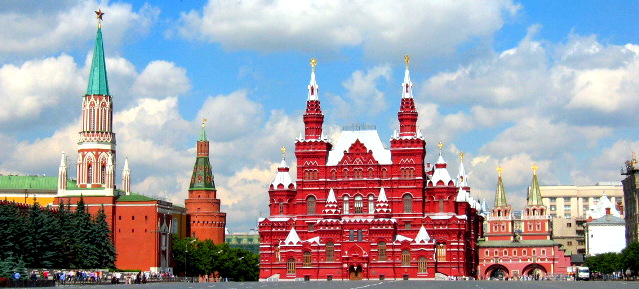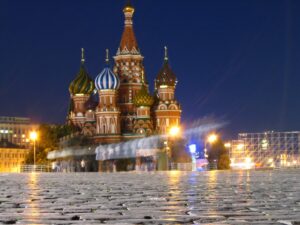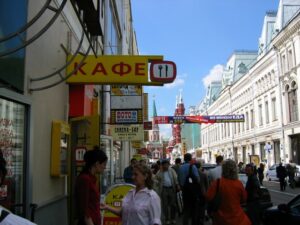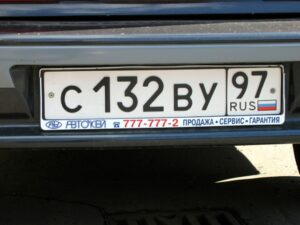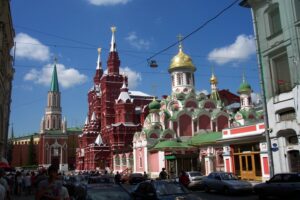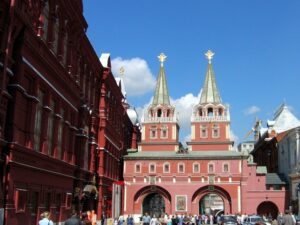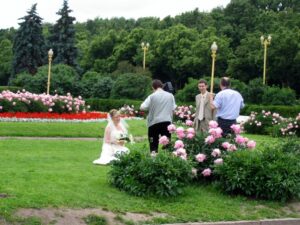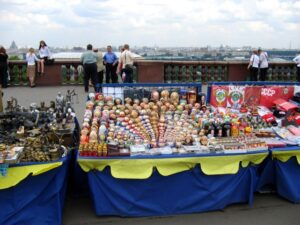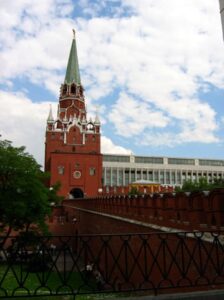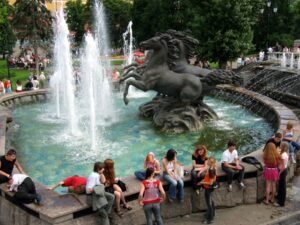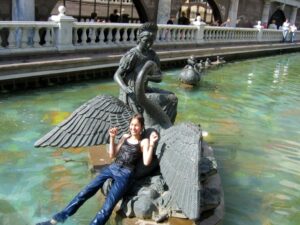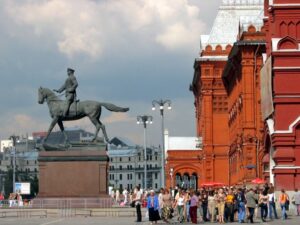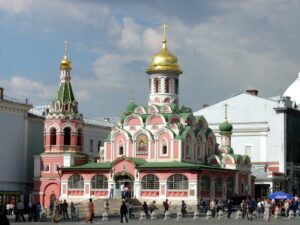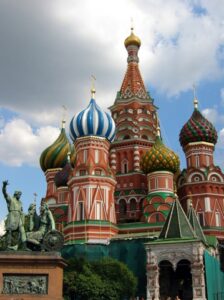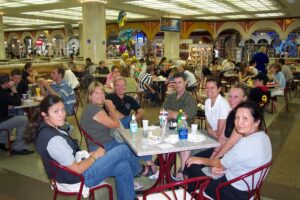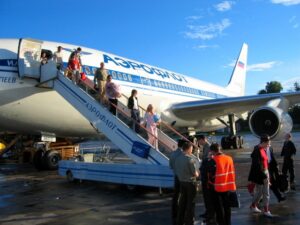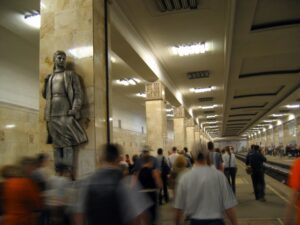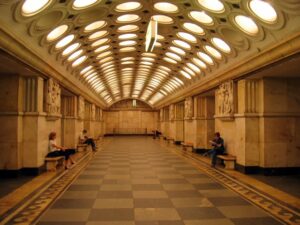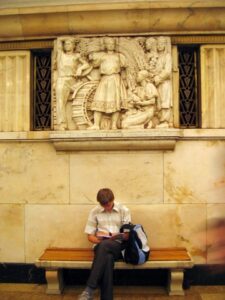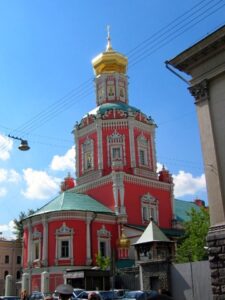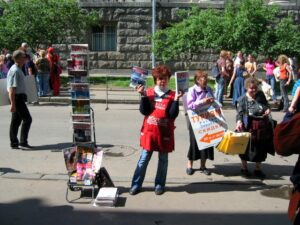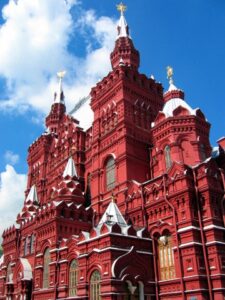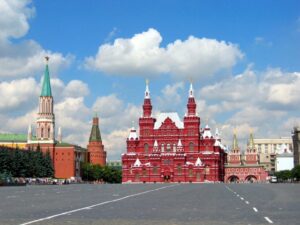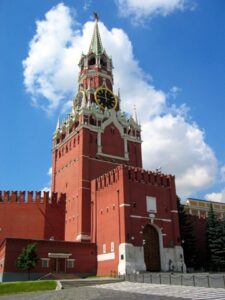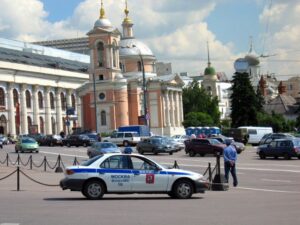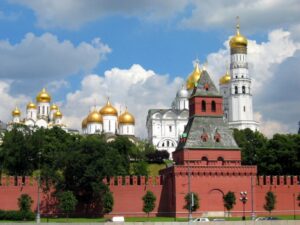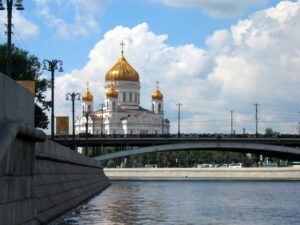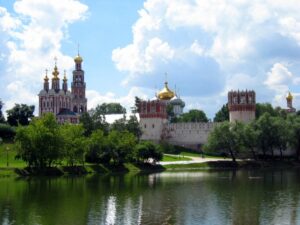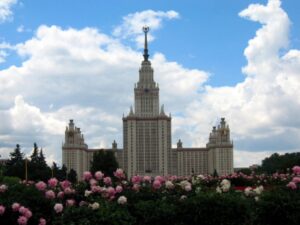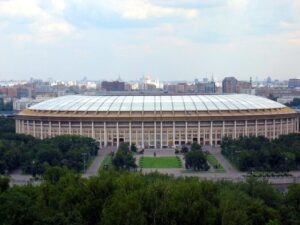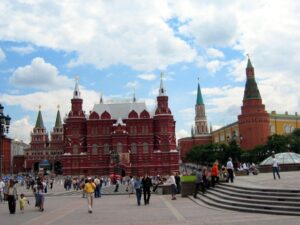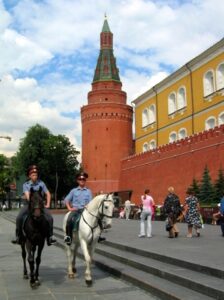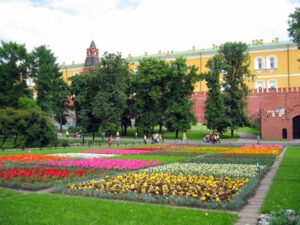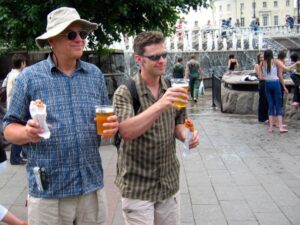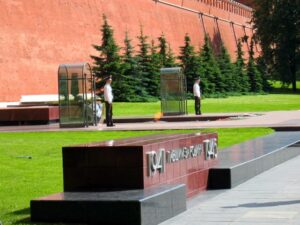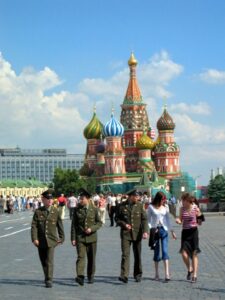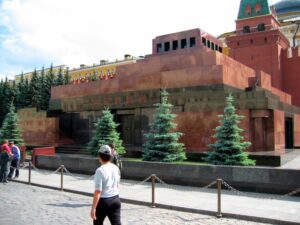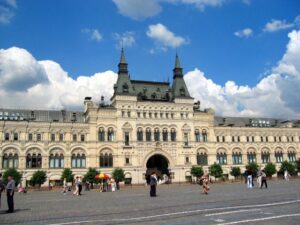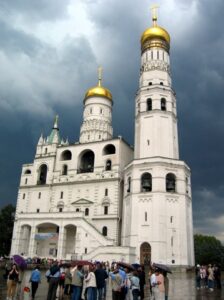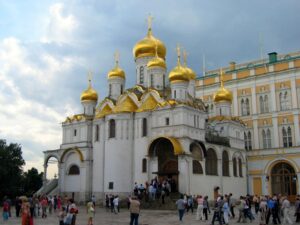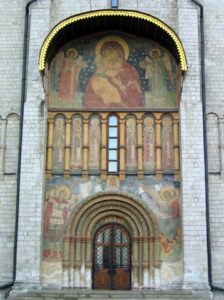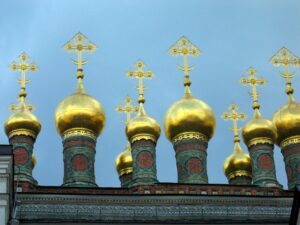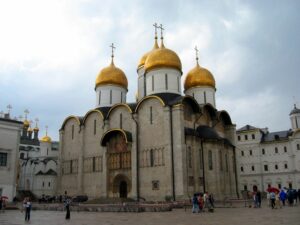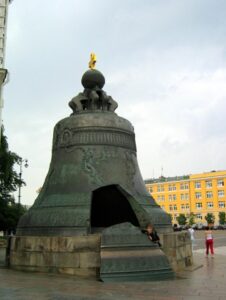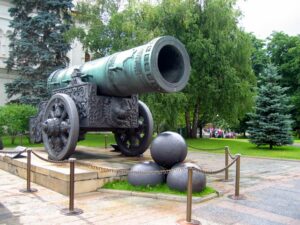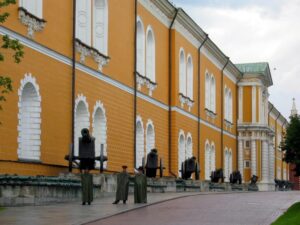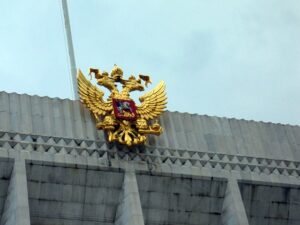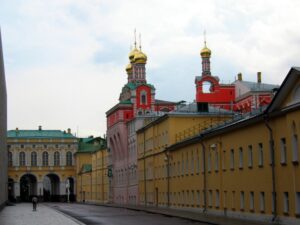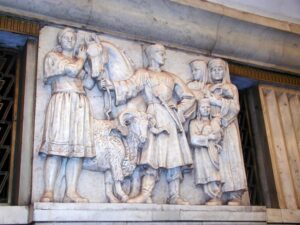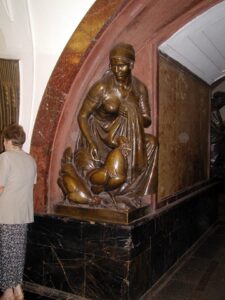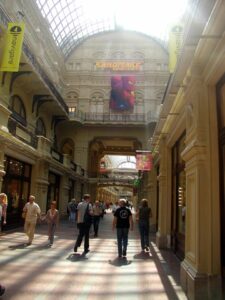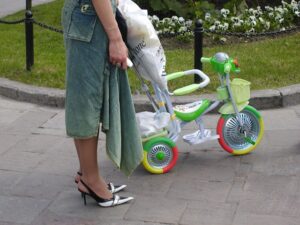Several days in Moscow is plenty of time to get in trouble and explore its more famous sights. We love Russia, and more especially, Moscow. Something about the sights of the Red Square, Kremlin, and Saint Basil’s Cathedral just takes our breath away. A ride on the subway is unforgettable as is the first bite into a freshly grilled sausage bought from a street vendor, downed by a 25 cent local beer. Moscow is a phenomenal city and we can’t wait for our next visit.
On our way to the 2004 Nadaam festival in Mongolia, we stopped in Moscow for a quick tour on both the outbound and inbound flights. We had enjoyed an extensive 9 day tour of Moscow and Saint Petersburg back in 2000 but were more than happy to visit one of our favorite European cities again only four years later. Moscow has an uncanny way of pulling your senses in and not letting go and we were excited to show off some of the highlights to Becky’s family. Our merry group consisted of eight intrepid travelers: Bob “Pops”, Ann “Ma”, Nancy “Traveler Galore”, Lisa “Cutie Pie”, Richard “Comedian Extraordinaire”, Frances “Cherry LT” and the two of us. Our plan was hatched back in 2003 when Becky heard of Mongolia’s national games (the “Nadaam” festival: held annually in Ulan Bator consisting of archery, horse races and wrestling). Like a woman possessed, she researched the best way to get there and decided on Explore Worldwide’s “Land of the Great Khan” tour. We planned on celebrating Frances’ upcoming graduation from West Point by buying her trip to Mongolia and ensured that our trip overlapped the Nadaam festival. When we mentioned our plan to the rest of our family, we were amazed that everyone expressed a desire to join us on this adventurous tour…hence the 8 member “Clark Clan” tromping about through the Gobi!
Fortunately, it was an added bonus that we were able to stop in Moscow for a whirlwind tour on our way to/from Ulan Bator. So, despite suffering from jetlag when our group reached Moscow’s Sheremetyevo-2 International airport in the early evening on 29 June, our adrenaline was pumping and we were gearing to head out for a night on the town. The airport is located about 35 km from Moscow so we had plenty of time to plan our evening. First, we had to check into the Izmailovo Delta Hotel and drop off our bags before rushing off to the Red Square.
The Izmailovo hotel complex consists of four separate blocks: Alfa, Beta, Vega and Delta/Gamma. It was constructed for the 1980 Moscow Olympics to accommodate the athletes attending the games and seems to have been persevered in a time warp ever since. When we checked in, we were impressed by the lobby’s posh décor and assumed that our rooms would be equally as nice…however, reality sunk in once we reached our rooms. These drab, depressing rooms have seen better days and the midget-sized beds forced us to sleep with our legs dangling over the edge but what the hell, we were in Moscow and happy to be here!
Becky asked the receptionist to write down the name of the Metro stop for Revolution Square in Cyrillic but because she didn’t understand English, Becky was forced to revert to German. The closest metro station, Ismailovskiy Park, is conveniently located only thirty meters from the hotel and we had no problems buying our bargain priced (30 cents) tickets to Revolution square. What we failed to realize was that wasn’t our biggest obstacle to face that night. Running through the dreaded ticket booth gauntlet was our true challenge. If you don’t slip your ticket in, wait for the green light, pull out your ticket and gingerly walk through the next three feet pass the barrier, (all of this must be in this precise sequence, absolutely no deviance is permitted!), a pair of highly unpleasant metal spokes will slam shut from the left and right barriers, effectively blocking your way to the awaiting train. Unfortunately, Richard learned this lesson the hard way on multiple occasions and taught all of us a valuable lesson…do not mess with the Moscow metro booths…it is a non-forgiving, brutal, losing battle that one will limp away from painfully.
We finally made our way onto the metro and counted out precisely five stops. At each stop, we admired the amazing murals and wall decorations. The Moscow metro is architecturally stunning and we enjoyed our brief ride to the Red Square. What is amazing is how deep the metros are buried beneath the city. We had to take a steep escalator ride to reach ground level. Unfortunately, one of our fellow passengers, a young Russian man, had been drinking heavily and reeked of vodka. He came tumbling down the escalator and body-slammed Becky who would have been hurled down even further if not for Ann’s heroics. She pushed back in the opposite direction and kept the balance, definitely saving Becky from an unpleasant tumble. The drunken man didn’t learn his lesson and as he attempted to stumble back up the escalator, he came rolling down again, splitting his head open and losing his belongings everywhere. We were really shocked at this open display of alcoholism and quickly realized that there are many young Muscovites that fail in their struggle to consume alcohol responsibly. Thankfully, no one from our party was injured and we attempted to help the stranger gather up his gear and assist him off the escalator in one piece. We quickly forgot the incident when we strolled upon the Red Square at night.
Prior to visiting the Red Square, we all had flashbacks of this image: stone-faced Soviet leaders wearing thick winter jackets and big furry hats standing at attention in the bitter cold, watching as an extraordinary show of military might marches smartly past the Lenin’s Mausoleum review stand. Those images of military pomp and ceremony were hard to drive out of our minds but as soon as we rounded the corner to the Red Square, our breath was taken aback. It truly is a spectacular sight to behold at night. With dimmed lights, the square is at its best. The panorama of St. Basil’s Cathedral, GUM department store, the History Museum, and Lenin’s Mausoleum was absolutely magical to experience in the cool, night air. We took several long exposure photos before wandering down towards Manezh Square. To reach the square, we had to walk under a newly constructed gate that connects the History Museum to the Lenin Museum. These gates were torn down in the 1930’s because they were a hindrance to the flow of Russian soldiers and their tanks during military parades in the Red Square. However, in the 1990s, they were rebuilt to their formal glory. On the other side of the gates, there is a circular bronze plaque that marks Moscow’s “zero kilometer spot”, with all distances in Russia measured from this location. It is a tradition to stand in the center and make a wish while throwing a coin over one’s shoulder. (However, don’t expect the coins to stay there long…there are plenty of eager old ladies scrambling about for the coins like vultures). Nancy wanted to know who the horseback rider was in front of the History Museum. We were unsure at the time but later found out that it is a statue of Field Marshall Zhukov, one of Russia’s World War II commanders. Just a few meters from the Kremlin sits the relatively new Manezh Square Shopping Center. Thankfully it is an underground mall and doesn’t ruin Moscow’s beautiful landscape. Just adjacent to the mall is Alexander Park, which was lit up with obscenely colorful lights late at night. Bob was on a quest for a midnight snack (Russian sausages) and headed down towards the Park looking for a booth. Unfortunately, it was well past midnight and the stands were shut down for the day. Half of our group trailed behind to admire the bronze statues depicting popular Russian folk tales. Since the metro stops running at one AM, we decided to make one last quick sweep of the Red Square before crashing for the night.
From Alexander Park, we made our way towards Lenin’s mausoleum, which was guarded by a soldier. The mausoleum was designed in 1924 and is very simple. It is a contrast of red granite (symbolizing communism) and black labradorite (symbolizing mourning) and contains the mummified body of Lenin. In 2000, we were unable to visit Lenin due to the long lines queuing up for this surreal experience but we can just imagine him lying there in his crystal coffin, unaffected by the massive changes sweeping across Russia. Our next stop was St. Basil’s Cathedral, which remained spectacular even in the dark. We could still make out the profusion of colors, shapes, domes, arches, spires and towers. Each section was unique and we were excited to see in it full daylight tomorrow. However, our priority now was to crash for a few hours before linking up with our tour group for a morning tour of Moscow. We made our way back to Izmailovo without major event and tried to snooze for a few hours.
The next morning, we scrambled to have breakfast, pack our bags, and check out of the hotel in time for the morning excursion in Moscow. Bob contacted his friend Mark, a US citizen who has called Moscow his home for a few years. They met briefly in the hotel lobby to reminisce for a few minutes before our tour kicked off. Meanwhile, high drama has occurred as we attempted to get everything organized and everyone down to the lobby in one piece. We finally made it by the skin of our teeth and with some tempers aflare, loaded up our bus and marched off towards the metro station. Our guide took us on a metro tour and we feel we are pros (been there, done that). During the day, the metro is a bustling hub. At the station on the way down, old men and women stand on the stairs selling items that range from gum to cigarettes to underwear…nothing is off limits. There are more old women than men and they are commonly referred to as “babushkas”. Today these cute babushkas are out in full force, trying their best to sell us something. Our guide led us off at most noteworthy metro stops to admire the intricate sculptures, painting, murals and hammer and sickle displays, all of which tout Russia’s military might or collective community pride. From there, we toured the Red Square again although the main part of the square has been blocked off. We were told this was because Lenin’s mausoleum was open to visitors, hence the entire square is blocked off but this defies logic…go figure! To get towards St. Basil’s, we are forced to walk through the GUM department store. Don’t expect any bargains here…the prices are often higher than those listed in the West. Our local tour guide gives us a brief lecture on the Red Square and then escorts us to our bus for a quick excursion around the city.
From our comfy bus, we cross over the Moskvoretsky Bridge and make our way to the Sofia Embankment, for a lovely panorama of the Kremlin. We stop briefly in front of the Christ the Savior Church, which is fairly new but looks as if it could have been there for ages! The Golden domes already appear dated and it was hard to imagine that this was erected only a few years ago. Next stop on our whirlwind tour is the Novodevichy Convent and Cemetery, a beautiful circa 1524 convent located on a picturesque bend in the Moskva River. Our tour guide explained to us that for centuries, the palaces and churches of the Kremlin were the only buildings made of stone, with the rest of the city constructed out of wood. With each great fire, of which ancient Moscow has more than its fair share, the city was completely destroyed and subsequently rebuilt. Therefore, it is both amazing and rare to find surviving ancient structures from Old Moscow. This convent is one of the lucky structures to have survived through the conflagrations over the years and we admired it from across the river. The history of the convent is pretty colorful. Back in the 1500s, Moscow’s Kremlin was a protective citadel for the city center. A series of fortified monasteries were built as outlying defensive structures, of which the Novodevichy Convent receives the most fame. This fame is not derived from its role as a defensive structure but because it was the favorite destination for the banishment of high-ranking women from the Tsar’s court. In fact, Peter the Great’s older sister, Sofia, was banished to the convent during his rule and sadly, it was here that she was driven mad when an attempted coup from the convent failed (Peter had the bodies of her supporters strung up outside her window which eventually made her crazy).
Moscow State University is our next stop. It is a large, oppressive and imposing building that stands 240 meters tall. This enormous building was commissioned by Stalin, along with 6 other similar buildings that became known as “The Seven Sisters”. In 2000, we quickly learned that the seven sisters are not good buildings to use as reference points as they are virtually indistinguishable from each other! Our tour guide made it a point to tell us that most Muscovites hate the seven sisters, either finding them ugly or oppressive. In fact, there is actually an 8th sister in existence, gifted to Warsaw, Poland. Apparently, the Poles don’t like their Stalin present either and these buildings remain immensely unpopular! Regardless of their popularity or lack thereof, we witnessed a young couple dressed in their wedding best pose for pictures in front of the University. It was highly reminiscent of the couples getting married in Kiev, right down to the limousine decorated with oversized “his and her” matching wedding bands on top of the roof. From the terrace in front of the University, dozens of souvenir stands were displaying their overpriced Soviet paraphernalia. The terrace also afforded a fantastic vista of Moscow and we could make out a nice panoramic view over the Luzhniki district of Moscow (including the Novodevichy Convent, Christ the Savior Church, glittering onion domes of the Kremlin, as well as the fellow sister buildings).
The formal portion of our Moscow excursion was complete. Since our flight to Ulan Bator was late this evening, we were given a few free hours loose in the city. Our guide offered an elective trip to the Kremlin’s Armory (an exhibition spanning several centuries of clothes, carriages, weaponry, silverwork, embroideries, and jewelry including the world famous Faberge eggs) but we all opted to have a quick lunch instead. The quickest and easiest place was at the Manezh underground mall where we grabbed a quick bite to eat. Afterwards, we headed for the Alexander Park and watched the locals revel in the sun by the fountains. Bob and Robby figured lunch wasn’t enough so they enjoyed some tasty local sausages and beer and we all hung out and killed time for a while. Afterwards, we had a leisurely stroll across the Red Square before joining the rest of our tour group for a ride back to Sheremetyevo-2 Airport. From there, our guide cautioned us about the process of getting our bags scanned by customs and checking in for the Aeroflot flight. Aeroflot didn’t have a representative handling check in yet so we hung out and met our fellow “Land of the Great Khan” travelers. There were no major hassles getting our luggage checked in and tickets issued but we did have to wait in a long queue for passport control. Thankfully, we had arrived with plenty of time to spare so there was no need to rush. Once we boarded the plane, the weather took a turn for the worse and we were advised that the flight would be delayed until things cleared up. Two hours later, we were off and on our way to Mongolia.
Two weeks later, we flew back into Moscow for a quick overnight stay to break up the flight plan from Ulan Bator to London Heathrow. Our group sadly bid farewell to Alex, Gerta and Eva, all of whom were leaving us for connecting flights elsewhere. We queued up in the dreaded passport control line and everyone was admitted through except for Liz. John was already through and he was trying to find out why she was being delayed. The only thing the surly passport officials would tell her was that the double entry visa was not valid and to wait for another official to arrive. An Iranian lady was in the same predicament so Liz and her new acquaintance commiserated together. Meanwhile, we collected all of our baggage and waited anxiously for Liz. Finally, when the official arrived and examined Liz’s visa, it was admitted with little to do that a mistake had been made and she could be admitted into the country after all. We were met by Olga again who rushed us out to the awaiting bus and straight to Hotel Izmailovo. She gave us a few recommendations on how to spend our free time and we decided to take her up on the advice after rushing off for a quick tour of the Kremlin first. Since time was extremely limited, we all agreed to meet back down in the lobby in a few minutes before hopping on a metro directly to the Red Square. Olga did warn us to bring rain gear as earlier that day (13 July), it has been storming pretty hard. We didn’t take her warning seriously and soon were caught in raging torrents of rain. Nancy was nice and dry with her rain parka but the rest of us soon looked like drowned rats and we scurried to the ticket booth to buy our admittance onto the grounds before they closed. Unfortunately, we only had an hour before the cathedrals would be closed but we decided to make the most of it.
The Kremlin is an amazing refuge of palaces, armories, and churches galore. It has a long and colorful history, serving as a medieval fortress that gained prominence only after Kiev (Ukraine) declined in power after the Mongol invasion. The Kremlin started off as a hunting lodge for Prince Yuri Dolgorukiy, perfectly situated on top of a hill overlooking the Moskva and Neglina rivers. Over time, Moscow was made the seat of the Russian Orthodox Church and under Ivan the Great’s leadership, Muscovite rule extended over all of Russia (with the Kremlin benefiting from Moscow’s elevated position). By 1480, the hunting lodge had been transformed into an imposing fortress, whose stone walls protected the amazing Cathedrals that we were about to visit. In fact, in the Cathedral of the Assumption, Ivan the Great dared to rip up the charter binding Moscow under Mongol rule! The shift of power went from Moscow to Saint Petersburg and the Kremlin declined for a few centuries until 1918, when the Bolsheviks’ chose Moscow as their capital city and re-catapulted the Kremlin back into prominence.
As we wandered through the Kremlin today, many of the functioning buildings were understandably closed off to tourists. However, the most exciting area to visit was Cathedral Square, where nine cathedrals (each built for a different religious purpose or for a different Tsar) are picturesquely placed. Most of the cathedrals are adorned with the traditional Russian golden onion-topped domes while on the inside, all of them were plastered with intricately painted walls and icons. It is amazing that Stalin did not destroy these priceless buildings when he directed Christianity purged throughout the country. The square is centered on the impressive Cathedral of the Assumption (built in the 1470s by Ivan the Great). It remained the focal point for political power within the country until Peter the Great shifted the capital to Saint Petersburg in 1710. Up until that move, Cathedral square remained the focal point for lavish ceremonies, coronations, nobility assemblies and stately rituals. Clustered all around the square are remnants from old Tsarist Russia: cathedrals, towers and palaces that collectively present an awe-inspiring panorama.
The rain eased up after a while and we were offered a brief respite to admire several of the cathedrals from within. Of course, the highlight of the square was the Assumption Cathedral. It is the oldest, largest and most important of the Kremlin’s numerous churches. An Italian from Bologna was hired to build the cathedral and did such a good job that Ivan imprisoned him (so he could not build a better cathedral elsewhere in the world!). The other imposing presence on Cathedral Square is Ivan the Great’s Bell tower. This looms over the entire Kremlin (it once held the honor of being the tallest structure in all of Russia). Measuring well over 80 meters and constructed of bright, white stone, the bell tower was completed in 1600 and dominated the skyline of Moscow for numerous centuries.
Two other curiosities we wandered by in the Kremlin were the Tsar Cannon and Tsar Bell. We didn’t realize it at the time but reading up on it later, we found out that this odd pair is unique in every possible sense. Not only are they the biggest of their kind in the world but neither one of them has ever been functional! The 40 ton Tsar Cannon was built during the reign of Ivan the Terrible’s son Fyodor. The barrel itself is over five meters long and has an 890 mm caliber! However, it never fired a single projectile (although in theory it could have fired massive wine- casket sized objects). The two hundred ton bell is also an interesting object to admire. It was never fully completed, much less rung. In 1737, the bell cracked after it fell into its own casting pit. A full 100 years passed before the bell was finally lifted and brought to where it stands today. Directly beside the bell lies a mere 11 ton scrap that fell from the bell during its excavation….imagine that falling on your feet!
The Kremlin grounds officially closed at 1700 and we reluctantly left. There was still so much to see and do but that will have to be for another time! We hopped on the metro towards the pedestrian street at Arbat. This pleasant pedestrian-only zone was full of souvenir sellers and restaurants, which were the next two things on our minds. Rich was in search of a Harley Davidson Moscow t-shirt for some friends while Nancy, Lisa and Becky were looking at the Matryoshka dolls. This street hasn’t changed much since 2000, although it looked a lot cleaner and bum-free. Muscovites were still lined up on a section in Arbat to sell pets and we looked at the puppies, kittens, birds, and reptiles for sale on the street corner. Dinner was at a Turkish restaurant and after eating our fill, we headed back towards the metro for a ride back to our hotel. Unfortunately, Richard had yet another run in with the metro ticket barricades…after witnessing the pure agony on his face, all of us felt extremely paranoid walking through. It all felt like a grand conspiracy with lady luck blowing extremely fickle. All we needed was for Richard’s bad luck to spread our way and we’d be in for a world of hurt! Thankfully, that was our last metro ride in Moscow so we didn’t have to deal with their barbaric “no free metro ride” security system anymore. We walked (Richard hobbled) back to our hotel and crashed for the night.
Last day with the entire Clark Clan! We got up early for breakfast and checked out of the hotel for our bus ride to the airport. Thankfully, we had plenty of time to get there and checking in was a piece of cake, as was passport control. We boarded our Aeroflot flight back to London Heathrow and several hours later, did a group hug and said goodbye to the rest of our travel group. As expected, we were all departing to the four corners of the world: Ann and Steve were catching trains home, Liz and John were also headed back home (with Ann, Bob, Fran, Nancy, Rich and Lisa planning on visiting them later on the week while on their Wales tour), Ushee’s husband was picking her up and she was quite anxious to see him, and lastly, Robby and Becky were rushing off to Germany (Becky going to Tallinn, Estonia the next day and Robby flying to Atlanta, USA). We all agreed that we had shared a marvelous trip together that would fuel numerous fond memories for years to come.
